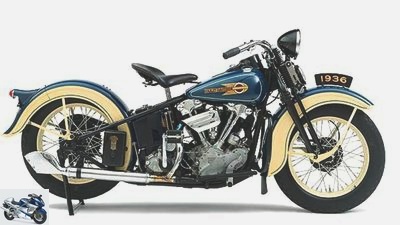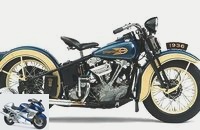Menus

Photos: Harley-Davidson
Finale: Harley-Davidson anniversary
75 years of Knucklehead cruisers
The ancestor of all modern Harley-Davidson motorcycles was born 75 years ago. Between the Great Depression and World War II, there was time for a pioneering development and a true two-wheeler icon.
Americans are rarely at a loss for pride, self-confidence, and superlatives: Of that "outstanding motorcycle of today" and at the same time that "Motorcycle of the future" is spoken in 1936 in Milwaukee, USA. We are talking about the Harley-Davidson model E. Welch a mundane name for such a fascinating product, say the fans of the brand, of which there were already plenty back then. And because the shape of the rocker arm housing of the brand new V2 reminds you so much of the knuckles of a clenched fist, they soon baptize the beautiful woman with the name "Knucklehead". That this doesn’t just translate "ankle-", but also "Moron" means, is mentioned here only in passing. The "Knuckle" is a quantum leap for the US brand, which is just 33 years old. And it is extremely daring, after all, the starting shot for its development was given as early as 1931.
At a time in which the economic crisis is holding the globe firmly in a stranglehold, an era in which sales are stagnating and companies are capitulating. The unemployment rate in the USA jumps to over 16 percent: Eight million US citizens are without wages or bread. The city of Chicago is so broke it can’t even pay its teachers for months. Even nature seems to conspire against humans: A devastating drought is turning large parts of the Midwest into landscapes of dust and causing food prices to rise.
Ze ready to bury your head in the sand? No sir! US President Hoover opens the Empire State Building in New York, which at 449 meters will be the tallest building in the world for the next 41 years. RCS immediately places a TV antenna on top, because TV is all the rage among those who can afford it. Jacob Schicks and Wallace Corothers inventions of the year should also have a glorious future: the electric shaver and nylon. Americans don’t give up, they say at the Harley-Davidson headquarters. Instead, Bill Harley and his associates Arthur, Walter and William Davidson choose to flee forward and develop a completely new technology carrier – strong, fast and beautiful.
Buy complete article

Finale: Harley-Davidson anniversary
75 years of Knucklehead cruisers
Knucklehead should now crown it all. And indeed: customers and the press are equally enthusiastic. They want bikes and they want performance. Better fuels enable the use of higher compressions, and it makes sense to use designs with overhead valves – designs like the E. That it is a completely new development can be seen from afar by the shape of the engine. It is still a 45-degree V2, but the area above the cylinder cooling fins is evidence of modern times. Its push rods flow into elegant rocker arm housings, each of which houses two overhead valves per cylinder. As an OHV – "overhead valve" – the technician describes this, in contrast to the previous SV models with laterally arranged valves. 61 cubic inches (1000 cm³) is the displacement, from which the twin draws up to 40 hp. In the EL version, the bike is nicknamed "Special Sport Solo" and higher compression. For the first time, Harley is using pressure circulating lubrication, in which the oil is pumped through the engine and back into the oil tank instead of escaping into the open.
Harley-Davidson
In addition to fancy hats, the “buddy seat” came into fashion in the 1940s, promoting intimate togetherness.
What nobody suspects in 1936: The Knucklehead V2 is the veritable ancestor of all future Harley engines. Basic design principles such as the number and arrangement of cylinders as well as the type of cooling and valve control have never changed again in the Big Twins from Milwaukee. But it is more than a technical highlight. William G. Davidson, the company’s founding grandson, design pope and H-D brand icon, is certain: "The Knuckle is one of the most beautiful models we have ever made, after all, it defined a look that still characterizes our motorcycles today." The Motor Company’s senior vice president and chief styling officer should know. Five copies count "Willie G." in his personal collection. He appreciates its characteristic engine, the grace of the silhouette, the harmonious proportions and the elegant details such as the tank console, which bundled all the displays for the first time in 1936. These include a speedometer – the first that Harley-Davidson mounts on a motorcycle as standard. Its large face stands out from the black console that crowns the tank.
1526 Knuckles roll out of the factory halls in 1936, almost $ 400 for each individual shop counter. For comparison: a loaf of bread costs eight cents, a gallon of gasoline ten cents, and the monthly rent for an average house is 24 dollars.
The 1937 model comes with more than 100 technical changes – including new engine bearings and connecting rod journals as well as various new oil seals. The Knucklehead should now show what it’s made of. A record is needed. Factory driver Joe Petrali takes over the job on the perfectly flat beach of Daytona. Joe drives a mighty knuckle: at the front, a disc wheel rotates in the clad fork, on which a gasoline tank converted into a cockpit cladding sits enthroned, while the rear consists of a streamlined sheet metal fin. Unfortunately, it is precisely this fin that causes the bike to oscillate to such an extent that it can be swapped for a standard part for the final record run. The V2, fed by two carburetors, is doped with a diabolical alcohol-benzene mixture to mobilize 67 hp. The engine, considered to be sensitive, passed the speed and temperature orgy with flying colors: On March 13, 1937, the completely fearless Joe reached the world speed record for motorcycles with 136.2 mph (almost 220 km / h), which was only to be broken eleven years later.
In 1941 Harley stepped on the gas again and increased the displacement of its OHV. 74 cubic inches (1213 cc) is now good for up to 48 horsepower. F and FL are the new, more powerful versions. In the last month of this fateful year, America ends the fun: On December 7th, Japanese planes bomb Pearl Harbor and one day later the USA enters World War II – every worker is now needed for military production. From 1943 onwards, motorcycles were no longer officially manufactured for the civilian market.
Harley-Davidson
Arthur and Walter Davidson, William S. Harley and William A. Davidson (from left) are there when the first Knucklehead is launched.
The Knuckle only continues after the end of the war. Not as quickly as you would like it to be in Milwaukee, because important raw materials are needed for reconstruction in Europe. One of the technical goodies in 1946 was the new hydraulic shock absorber – not on the rear, for example, but on the jumper fork. A telescopic fork, already tested in 1946, is no longer used in the Knuckle, because production ends in 1947. As a farewell, the Motor Company donated her the Streamline instrument panel and the tombstone taillight.
The 47 FL costs $ 605, and $ 590 "small" Tbsp. Anyone who has around 700 bucks more in their wallet can get into an average new car. The price doesn’t detract from the success of the Knuckle. Of the almost 36,900 units that were built between 1936 and 1947, Harley sold over 10,000 in the last year of production. If you don’t want to buy a Knuckle until 75 years after its debut, you must have a credit of at least 30,000 euros in addition to a big heart for classic cars. Fortunately, there are their many cheaper offspring: They are called Sportster, Dyna, Softail and Touring.
Related articles
-
Retro bike Harley-Davidson Softail Slim
10 photos 1/10 Harley-Davidson Softail Slim: 103 cubic inches correspond to 1690 cm³. 2/10 Harley-Davidson Softail…
-
60 years of the Harley-Davidson Sportster
Harley-Davidson 18th photos Harley-Davidson 1/18 2017 – For gourmets: Cafe Custom Accessories. Harley-Davidson 2/18 Why women play a role in advertising…
-
Harley-Davidson Model 11F and Indian Twin Model F
Fred Siemer 25th photos Fred Siemer 1/25 Harley-Davidson Model 11F and Indian Twin Model F. Fred Siemer 2/25 The Harley has been beautifully restored and…
-
Top test Harley-Davidson VRSCA V-Rod
fact Top-Test Harley-Davidson VRSCA V-Rod Emotional rescue Words are missing. At least the Germans. Because just at the time when the …
-
Cult bike Harley-Davidson FXS Low Rider
Archive cult bike Harley-Davidson FXS Low Rider “Factory Custom Motorcycle” “Factory Custom Motorcycle” – the (supposedly) individual motorcycle ex works …
-
Harley-Davidson Electra Glide, Honda Gold Wing and Yamaha Vmax
Bilski 48 photos Bilski 1/48 Three rolling icons, sculptures on wheels, celebrate 2015 rounds Birthday. Motorcycles that almost everyone knows, together…
-
Harley-Davidson Fat Bob put to the test
Harley-Davidson Fat Bob put to the test The dynamic promise Harley says the performance of the new Fat Bob would take your breath away. The…
-
Harley-Davidson Electra – Street Glide – Brands, Myths and Engines
Gargolov Comparison test: Harley-Davidson Electra / Street Glide Brands, Myths and Engines Pounding V2 bumper engines, heavy metal, archaic technology: a…
-
Harley Knucklehead and Springer Classic
Harley Knucklehead and Springer Classic Progress was yesterday Gigantic flywheels, groaning electric starters, rumbling engines, cracking gears. The…
-
25 years of the Harley-Davidson Fat Boy
markus-jahn.com 25 years of the Harley-Davidson Fat Boy Big in business Content of In 1990 Harley-Davidson brought a true style icon with the Fat Boy….